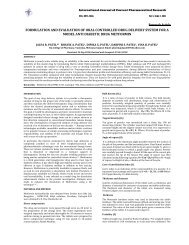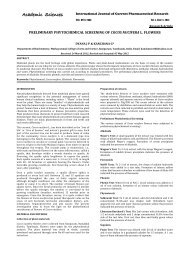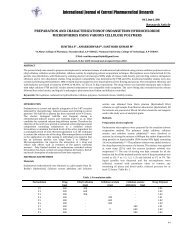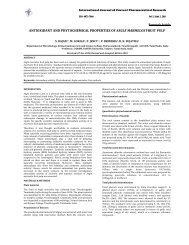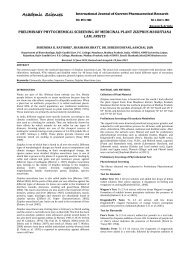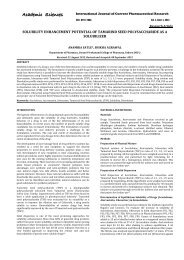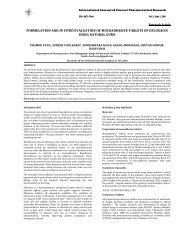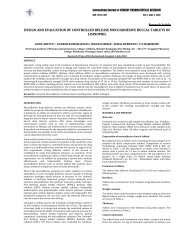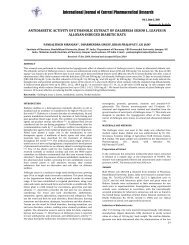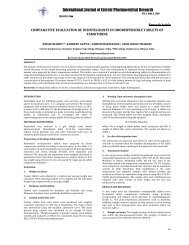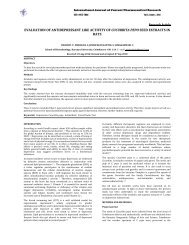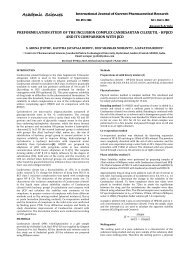antioxidant potential of some novel schiff bases containing ...
antioxidant potential of some novel schiff bases containing ...
antioxidant potential of some novel schiff bases containing ...
Create successful ePaper yourself
Turn your PDF publications into a flip-book with our unique Google optimized e-Paper software.
Academic SciencesInternational Journal <strong>of</strong> Current Pharmaceutical ResearchISSN- 0975-7066 Vol 5, Issue 1, 2013Research ArticleSTRUCTURE ACTIVITY RELATIONSHIP: ANTIOXIDANT POTENTIAL OF SOME NOVEL SCHIFFBASES CONTAINING BENZOPHENONE MOIETYGHULAM FAREED 1,2 *, MUHAMMAD ALI VERSIANI 2 , NIGHAT AFZA 1 , NAZIA FAREED 2 , LUBNA IQBAL 1 , ANDMEHREEN LATEEF 11Pharmaceutical Research Center, PCSIR Laboratories Complex Karachi, Karachi-75280, Pakistan, 2 Department <strong>of</strong> Chemistry, FederalUrdu University <strong>of</strong> Arts, Science and Technology, Ghulshan-e-Iqbal, Karachi-75300. Sindh, Pakistan. Email: fareedchm@yahoo.comABSTRACTReceived: 19 December 2012, Revised and Accepted: 31 December 2012An efficient and facile condensation <strong>of</strong> 2-aminobenzophenone with different carbonyls yields <strong>novel</strong> Schiff <strong>bases</strong> (1-11) in the presence <strong>of</strong>dodecatungstosilicic acid / P2O5 in solvent free conditions. The products were obtained in high yield on grinding the reaction mixture for 1-3minutes. The structures <strong>of</strong> the products were characterized using spectroscopic techniques and elemental analysis. DPPH radical scavenging activity<strong>of</strong> all the compounds was carried out using BHA as a standard. Compound (3) showed 51% <strong>antioxidant</strong> <strong>potential</strong> while all other compounds werefound to have moderate to mild <strong>antioxidant</strong> activity ranging from 20-48%.Keywords: Antioxidant activity, Schiff <strong>bases</strong>, Dodecatungstosilicic acid, P2O5, DPPHINTRODUCTIONBimolecular condensation <strong>of</strong> primary amine with a carbonyl groupyields a versatile class in the organic synthesis, which is known asSchiff Base or Imines. It has numerous appliances in the field <strong>of</strong>biological, inorganic and analytical chemistry [1-5]. Organicreagents play vital role in modern analytical devices in order toenhance the selectivity and sensitivity <strong>of</strong> optical andelectrochemical sensors as well as in many chromatographicmethods[6-8]. Schiff <strong>bases</strong> have excellent features and structuralsimilarities among these reagents. The facile method <strong>of</strong>preparation and synthetic simplicity <strong>of</strong> imines enables to designsuitable structural properties[9-10]. In coordination chemistry,azomethine moiety form complexes with a variety <strong>of</strong> metals[11-12]. Imines have broad applications as organic intermediates forthe preparation <strong>of</strong> pharmaceutical, or rubber additives[13] andprotecting agent for amino group in organic synthesis[14]. Theyhave also used as liquid crystals[15] and in polymerchemistry[16]. Schiff <strong>bases</strong> have broad applications in biologicalfield including antitumor[17], <strong>antioxidant</strong>[18], antifungal [19],antibacterial[20-24], herbicidal[25], antiproliferative[26],anticonvulsant[27], antimalarial[28], and anticancer activity [29].In view <strong>of</strong> the wide applications <strong>of</strong> imines, we also wish to reportherein the synthesis, characterization, scavenging activity <strong>of</strong> <strong>novel</strong>Schiff <strong>bases</strong> (1-11), which were synthesized using 2-aminobenzophenone with a variety <strong>of</strong> carbonyls in the presence <strong>of</strong>dodecatungstosilicic acid / P2O5 as a catalyst under solvent freeconditions [30-31] (Scheme 1 & Table 1). The structures <strong>of</strong> thesynthesized compounds were elucidated using spectroscopic dataand elemental analysis.MATERIALS AND METHODSThe melting points were taken in capillary using Gallenkamp MF-370 melting point apparatus and are uncorrected. 1 H-NMR wasrecorded on Bruker AV-300 operating at 300 MHz using dimethylsulfoxide (DMSO) with trimethyl silane (TMS) as an internalstandard. IR spectra were recorded on Nicolet Avatar 300 DTGS.EIMS spectra were recorded on Finnigan MAT-311. Elementalanalysis was performed on a Carlo Erba Strumentazion- Mod-1106,Italy. The purity <strong>of</strong> compounds was determined by using thin layerchromatography (TLC) which were pre-coated silica gel glass plates(Kieselgel 60, 254, E. Merck, Germany) and were visualized by UV at254 and 365 nm or by iodine vapors.General Method for the Synthesis <strong>of</strong> Schiff <strong>bases</strong> 1-11A mixture <strong>of</strong> 2-aminobenzophenone (1mmol), aromatic substitutedcarbonyls (1mmol) and dodecatungstosilicic acid / P2O5 (0.2g, 1mole%<strong>of</strong> P2O5 / 2-aminobenzophenone) was grinded in mortar with a pestlein solvent free conditions at room temperature for 1-3 minutes(Scheme 1). The reaction mixture turned pasty at the completion <strong>of</strong>the reaction. Precipitates <strong>of</strong> the Schiff <strong>bases</strong> formed upon addition <strong>of</strong>ice cooled distilled water, filtered and repeatedly washed with icecooled water. The target molecules were obtained in excellent yields.(2-{[(4-hydroxyphenyl)methylidene]amino}phenyl)(phenyl)methanone (1)Yield: 75%; m. p. 265-267 °C; Anal. Calcd. for C20H15NO2 : C, 79.72; H,5.02; N, 4.65. Found: C, 79.70; H, 4.99; N, 4.63; IR (KBr, cm -1 ): 3400 (-OH), 2962 (C-H), 1705 (C=O), 1672 (C=N), 1596 (C=C); 1 H-NMR(300MHz, DMSO-d6, δ / ppm): 8.70 (s, 1H, N=CH); EI-MS (m/z): 301.(2-{[(3-hydroxyphenyl)methylidene]amino}phenyl)(phenyl)methanone (2)Yield: 82%; m. p. 255-257 °C; Anal. Calcd. For C24H22N2O: C20H15NO2: C,79.72; H, 5.02; N, 4.65. Found: C, 79.71; H, 5.01; N, 4.64; IR (KBr, cm -1 ):3400 (-OH), 2965 (C-H), 1706 (C=O), 1674 (C=N), 1595 (C=C); 1 H-NMR(300MHz, DMSO-d6, δ / ppm): 8.71 (s, 1H, N=CH); EI-MS (m/z): 301.(2-{[(phenyl)methylidene]amino}phenyl)(phenyl)methanone (3)Yield: 93%; m. p. 220-222 °C; Anal. Calcd. For C20H15NO: C, 84.19; H,5.30; N, 4.91. Found: C, 84.17; H, 5.28; N, 4.90; IR (KBr, cm -1 ): 2966(C-H), 1709 (C=O), 1678 (C=N), 1598 (C=C); 1 H-NMR (300MHz,DMSO-d6, δ / ppm): 8.69 (s, 1H, N=CH); EI-MS (m/z): 285.(2-((furan-2-ylmethylene)amino)phenyl)(phenyl)methanone (4)Yield: 84%; m. p. 198-200 °C; Anal. Calcd. for C18H13NO2 : C, 78.53; H,4.76; N, 5.09. Found: C, 78.52; H, 4.74; N, 5.09; IR (KBr, cm -1 ): 2966(C-H), 1704 (C=O), 1675 (C=N), 1598 (C=C); 1 H-NMR (300MHz,DMSO-d6, δ / ppm): 8.64 (s, 1H, N=CH), EI-MS (m/z): 275.(2-{[(3-chlorophenyl)methylidene]amino}phenyl)(phenyl)methanone (5)Yield: 87%; m. p. 267-269 °C; Anal. Calcd. for C20H14ClNO: C, 75.12; H,4.41; N, 4.38. Found: C, 75.14; H, 4.40; N, 4.36; IR (KBr, cm -1 ): 2966(C-H), 1704 (C=O), 1671 (C=N), 1592 (C=C); 1 H-NMR (300MHz,DMSO-d6, δ / ppm): 8.66 (s, 1H, N=CH), EI-MS (m/z): 319.5.
Fareed et al.Int J Curr Pharm Res, Vol 5, Issue 1, 61-64R 1O NH 2R 1 OONPh+Hdodeca-Tungstosilicic acid/ P 2 O 5r.t., 1-3 min.Ph3a2a4a6a5a1-111213ON211109543Scheme 1: Synthesis <strong>of</strong> Schiff <strong>bases</strong>Table 1: Synthesis and <strong>antioxidant</strong> activity <strong>of</strong> Schiff <strong>bases</strong> 1-11S. No. R 1 R.T Antioxidant Activity (%) S. No. R 1 R.T Antioxidant Activity (%)(min.)(min.)11 29 73 212OH1 30 8NO 2NO 23 20OH3 1 51 91 4845O2 30 102 40 11ClOHOCH 32 313 20OH6Cl2 20 - - - -NO 2(2-{[(4-nitophenyl)methylidene]amino}phenyl)(phenyl)methanone (6)Yield: 90%; m. p. 233-235 °C; Anal. Calcd. For C20H214N2O3: C, 72.72;H, 4.72; N, 8.48. Found: C, 72.71; H, 4.70; N, 8.46; IR (KBr, cm -1 ):2964 (C-H), 1705 (C=O), 1675 (C=N), 1595 (C=C); 1 H-NMR (300MHz,DMSO-d6, δ / ppm): 8.70 (s, 1H, N=CH), EI-MS (m/z): 330.(2-{[(3-nitophenyl)methylidene]amino}phenyl)(phenyl)methanone (7)Yield: 85%; m. p. 187-189 °C; Anal. Calcd. for C20H214N2O3: C, 72.72;H, 4.72; N, 8.48. Found: C, 72.70; H, 4.71; N, 8.47; IR (KBr, cm -1 ):2964 (C-H), 1701 (C=O), 1677 (C=N), 1598 (C=C); 1 H-NMR (300MHz,DMSO-d6, δ / ppm): 8.69 (s, 1H, N=CH), EI-MS (m/z): 330.62
Fareed et al.Int J Curr Pharm Res, Vol 5, Issue 1, 61-64(2-{[(2-nitophenyl)methylidene]amino}phenyl)(phenyl)methanone (8)Yield: 65%; m. p. 210-212 °C; Anal. Calcd. for C20H214N2O3: C, 72.72;H, 4.72; N, 8.48. Found: C, 72.70; H, 4.71; N, 8.47; IR (KBr, cm -1 ):2964 (C-H), 1702 (C=O), 1678 (C=N), 1596 (C=C); 1 H-NMR (300MHz,DMSO-d6, δ / ppm): 8.67 (s, 1H, N=CH), EI-MS (m/z): 330.(2-{[(4-chlorophenyl)methylidene]amino}phenyl)(phenyl)methanone (9)Yield: 82%; m. p. 277-279 °C; Anal. Calcd. for C20H14ClNO: C, 75.12; H,4.41; N, 4.38. Found: C, 75.12; H, 4. 41; N, 4.37; IR (KBr, cm -1 ): 2966(C-H), 1704 (C=O), 1671 (C=N), 1592 (C=C); 1 H-NMR (300MHz,DMSO-d6, δ / ppm): 8.66 (s, 1H, N=CH), EI-MS (m/z): 319.5.(2-{[(4-hydroxy-3-methoxyphenyl)methylidene]amino}phenyl)(phenyl)methanone (10)Yield: 89%; m. p. 278-280 °C; Anal. Calcd. for C21H17NO3: C, 76.12; H,5.17; N, 4.23. Found: C, 76.10; H, 5.15; N, 4.21; IR (KBr, cm -1 ): 3402 (-OH), 2966 (C-H), 1704 (C=O), 1675 (C=N), 1598 (C=C); 1 H-NMR(300MHz, DMSO-d6, δ / ppm): 8.71 (s, 1H, N=CH), EI-MS (m/z): 331.(2-((1-(2-hydroxyphenyl)ethylidene)amino)phenyl)(phenyl)methanone (11)Yield: 89%; m. p. 289-291 °C; Anal. Calcd. for C21H17NO2: C, 79.98; H,5.43; N, 4.44. Found: 79.97; H, 5.40; N, 4.43; IR (KBr, cm -1 ): 3402 (-OH), 2966 (C-H), 1704 (C=O), 1675 (C=N), 1598 (C=C); 1 H-NMR(300MHz, DMSO-d6, δ / ppm): 2.31 (s, 3H, CH3), EI-MS (m/z): 315.DPPH Radical Scavenging ActivityThe <strong>antioxidant</strong> activity was assessed by measurement <strong>of</strong>scavenging ability <strong>of</strong> the isolated compounds on free radical 2, 2’-diphenyl-1- picryl hydrazyl i.e. DPPH. 90 µl <strong>of</strong> 0.3 mM DPPH solution(in ethanol) was added to 10 µl <strong>of</strong> each <strong>of</strong> the concentration <strong>of</strong>fraction, the mixture was incubated for 30 minutes at 37˚C, thenabsorbance was measured at 517 by microtitre plate reader (Spectramax plus 384 Molecular devices USA). BHA was used as positivecontrol. The results are depicted in (Table 1).Where;% DPPH scavenging effect = Ac-As/ Ac x 100Ac = Absorbance <strong>of</strong> control (DMSO treated); As = Absorbance <strong>of</strong>SampleRESULTS AND DISCUSSIONChemistryBenzophenone moiety <strong>containing</strong> <strong>novel</strong> Schiff <strong>bases</strong> (1-11) weresynthesized using bimolecular condensation reaction <strong>of</strong> 1-aminobenzophenone with a variety <strong>of</strong> aromatic carbonyls in the presence<strong>of</strong> dodeca-tungstosilicic acid / P2O5 under solvent free conditions(Table 1). The completion <strong>of</strong> the reaction was monitored by thinlayer chromatography (TLC). The synthesized products werecharacterized by using different spectroscopic techniques andelemental analysis.1H-NMRThe synthesized compounds were subjected to 1 H-NMR technique inDMSO. 1 H-NMR <strong>of</strong> all the compounds are very simple and –N=CH-Ar<strong>of</strong> all the synthesized Schiff <strong>bases</strong> apears in the region <strong>of</strong> 8.6-8.7ppm. The free NH2 group apears as a singlet in the region <strong>of</strong> 4-6ppm. The absence <strong>of</strong> this signal confirmed the formation <strong>of</strong> <strong>schiff</strong><strong>bases</strong>. In case <strong>of</strong> phenolic protons which shows hydrogen bondingwith the nitrogen <strong>of</strong> Schiff <strong>bases</strong> are resonate as sharp peak. Thearomatic protons appears as a multiplet in the region <strong>of</strong> 6.74-7.90ppm depending on the aromatic substituent.Infra RedIn FT-IR spectrum –N=C- apears in the region <strong>of</strong> 1670-1680 cm -1whereas, aromatic C=C viberate at 1610-1600 cm -1 . Free NH2 groupvibrate at 3400 cm -1 as a sharp two peaks. This signal was absent inthe observed infra red spectrum which indicated the formation <strong>of</strong>Schiff <strong>bases</strong>.Antioxidant-Structure Activity RelationshipFree radicals play a very important role in the pathogenesis <strong>of</strong>various human diseases and aging. In food products free radicalsalso cause damage, resulting in diminish taste and shelf life.Antioxidants are therefore protecting against free radicals and savehealth. Mostly strong <strong>antioxidant</strong>s activity is shown by polyphenols.The aim <strong>of</strong> our study was to explore the most potent <strong>antioxidant</strong> andexamine the factors that give a picture and establish the <strong>antioxidant</strong>activity with frequent comparison to various Schiff <strong>bases</strong> <strong>containing</strong>benzophenone moiety (Table 1). The results revealed thatcompound (3) showed highest % scavenging <strong>potential</strong> (51%) in allthe screened compounds, whereas all the other synthesizedcompounds showed moderate to mild <strong>antioxidant</strong> activity rangingfrom 20-48%. Although we don’t have exact classification withregard to higher or lower <strong>antioxidant</strong> activity. It is also thought thatthe large conjugated system and low steric hindrance in the framework <strong>of</strong> Schiff base benefit the Schiff base to trap radicals.Compound (3) which is less sterically hindered as compared to theall screened compounds showed 51% <strong>antioxidant</strong> activity due to itslow steric hindrance, while halogen (Cl) <strong>containing</strong> Schiff <strong>bases</strong> (5and 9) showed moderate % scavenging activity i.e., 40% and 48 %respectively. The reason for their behavior may be explained in sucha way that, generally electron donating group has a good ability tocatch free radicals by themselves. Due to extra stabilization radicalobtained compound having chlorine would have higher aptitude totrap free radical in a faster rate than the other similar compound. Allthe other compounds showed mild <strong>antioxidant</strong> activity.ACKNOWLEDGEMENTAll authors wish to thank PCSIR Laboratories Complex, Karachi forproviding facilities for this research work.REFERENCES1. Cimerman, Z., Miljanic, S. and Galic N. 2000. Schiff <strong>bases</strong>derived from amino pyridines as spectro fluorimentricanalytical reagents, Croatica Chemica Acta, CACAA – 73: 81- 95.2. Singh, P., Goel, R. L. and Singh, B. P. 1975. 8-acetyl-7-hydroxy-4-methyl coumarin as a gravimetric reagent for Cu 2+ and Fe3 + ,Journal <strong>of</strong> Indian Chemical Society, 52: 958-959.3. Perry, B. F., Beezer, A. E., Miles, R. J., Smith, B. W., Miller, J. andNascimento, M. G. 1988. Evaluation <strong>of</strong> microcalorimetry as adrug bioactivity screening procedure, application to a series <strong>of</strong><strong>novel</strong> Schiff base compounds, Microbois, 45:181-191.4. Kabak, M., Elmali, A. and Elerman, Y. 1999. Keto-EnolTautomerism, Conformations and Structure <strong>of</strong> N-(2-Hydroxy-5-Methylphenyl)-2-Hydroxybenzaldehydeimine, Journal <strong>of</strong>Molecular Structure, 477: 151–158.5. Patel PR, Thaker BT Zele S. (1999). Preparation andcharacterization <strong>of</strong> <strong>some</strong> lanthanide complexes involving aheterocyclic beta –diketone, Indian Journal <strong>of</strong> Chemistry, 38A:563-566.6. Valcarcel, M. and Laque de Castro, M. D. Flow-ThroghBiochemical Sensors, Elsevier, Amsterdam; 19947. Spichiger-Keller U. Chemical Sensors and Biosensors forMedical and Biological Applications, Wiley-VCH, Weinheim;1998.8. Lawrence, J. F. and Frei, R. W. Chemical Derivatization inChromatography, Elsevier, Amsterdam; 1976.9. Patai, S. The Chemistry <strong>of</strong> the Carbon-Nitrogen Double Bond, J.Wiley & Sons, London; 1970.10. Jungreis, E. and Thabet, S. Analytical Applications <strong>of</strong> Schiff<strong>bases</strong>, Marcell Dekker, New York; 1969.11. Arora, K. and Sharma, K. P. 2003. Studies on MononuclearChelates Derived from Substituted Schiff Base Ligands (Part 4):Synthesis and Characterization <strong>of</strong> a New5-Hydroxysalicyliden-P-Aminoacetophenoneoxime and Its Complexes with Co(II),Ni(II), Cu(II) and Zn(II), Synthesis and Reactivity in Inorganicand Metal-Organic Chemistry, 32: 913.63
Fareed et al.Int J Curr Pharm Res, Vol 5, Issue 1, 61-6412. Vigato, P. A. and Tamburini, S. 2004. The challenge <strong>of</strong> cyclic andacyclic Schiff <strong>bases</strong> and related derivatives, CoordinationChemistry Reviews, 248: 1717-2128.13. Macho, V., Kralik, M., Hudec, J. and Cingelova, J. 2004 One stagepreparation <strong>of</strong> Schiff's <strong>bases</strong> from nitroarenes, aldehydes andcarbon monoxide at presence <strong>of</strong> water, Journal <strong>of</strong> MolecularCatalysis A: Chemical, 209: 69-73.14. Bey, P. and Vevert, J. P. 1977. Preparation <strong>of</strong> Schiff <strong>bases</strong> <strong>of</strong>aminocycloalkane carboxylic acids esters. Tetrahedron Letters,18: 1455-1458.15. Adams, J. P. 2000. Imines, enamines and oximes, Journal <strong>of</strong>Chemical Society Perkin Trans I, 125-139.16. Johnson, D. M., Reybuck, S. E., Lawton, R. G. and Ramussen, P. G.2005. Condensation <strong>of</strong> DAMN with conjugated aldehydes andpolymerizations <strong>of</strong> the corresponding imines. Macromolecules,38: 3615-3621.17. Isaacs, N. S. 1976. Synthetic routes to β-lactams. ChemicalSociety Review, 5:181-202.18. Rada, B. and Leto, T. L. 2008. Oxidative innate immune defensesby Nox/Duox family NADPH oxidases, Contributions toMicrobiology, 15:164-87.19. Singh, W. M. and Dash B. C. 1988. Synthesis <strong>of</strong> <strong>some</strong> new Schiff<strong>bases</strong> <strong>containing</strong> thiazole and oxazole nuclei and theirfungicidal activity, Pesticides, 22: 33-37.20. Faizul, A., Satendra, S., Sukhbir, L. K. and Om, P. 2007. Synthesis<strong>of</strong> Schiff <strong>bases</strong> <strong>of</strong> naphtha[1,2-d] thiazol-2-amine and metalcomplexes <strong>of</strong> 2-(2′ hydroxy) benzylideneaminonaphthothiazole as <strong>potential</strong> antimicrobial agents, Journal <strong>of</strong>Zhejiang University Science-B, 8: 446-452.21. More, P. G., Bhalvankar, R. B. and Pattar, S. C. 2001. Synthesisand biological activities <strong>of</strong> Schiff <strong>bases</strong> <strong>of</strong> aminothiazoles,Journal <strong>of</strong> Indian Chemical Society, 78: 474-475.22. El-Masry, A. H., Fahmy, H. H. and Abdelwahed, S. H. A. 2000.Synthesis and antimicrobial activity <strong>of</strong> <strong>some</strong> newbenzimidazole derivatives, Molecules. 5: 1429-1438.23. Baseer, M. A., Jadhav, V. D., Phule, R. M., Archana, Y. V. andVibhute, Y. B. 2000. Synthesis and antimicrobial activity <strong>of</strong><strong>some</strong> new Schiff <strong>bases</strong>, Orient Journal <strong>of</strong> Chemistry, 16: 553-556.24. Pandeya, S. N., Sriram, D., Nath, G. and De Clercq, E. 1999.Synthesis and antimicrobial activity <strong>of</strong> Schiff and Mannich<strong>bases</strong> <strong>of</strong> isatin and its derivatives with pyrimidine, IL Farmaco,54: 624-628.25. Samadhiya, S. and Halve, A. 2001. Synthetic utility <strong>of</strong> Schiff<strong>bases</strong> as <strong>potential</strong> herbicidal agents, Orient Journal <strong>of</strong>Chemistry, 17: 19-122.26. Nawrocka, W. P., Sztuba, B., Drys, A., Wietrzyk, J., Kosendiak, J.and Opolski, A. 2006 Reaction <strong>of</strong> aromatic aldehydes with 2-aminobenzimidazole by using catalytic amount <strong>of</strong> M(NO3)2.xH2 O, Polish Journal <strong>of</strong> Chemistry, 80: 279-287.27. Verma, M., Pandeya, S. N., Singh, K. N. and Stables, J. P. 2004.Anticonvulsant activity <strong>of</strong> Schiff <strong>bases</strong> <strong>of</strong> isatin derivatives, ActaPharmaceutica, 54: 49–56,28. Tsafack, A., Loyevski, M., Ponks, P. and Cabantchik, Z. I. 1996.Mode <strong>of</strong> action <strong>of</strong> iron (III) chelators as antimalarials. IV.Potentiation <strong>of</strong> desferal action by benzoyl and isonicotinoylhydrazone derivatives, Journal <strong>of</strong> Laboratory and ClinicalMedicine, 127: 574-582.29. Desai, S. B., Desai, P. B. and Desai, K. R. 2001. Synthesis <strong>of</strong> <strong>some</strong>Schiff <strong>bases</strong>, thiazolidones, and azetidinones derived from 2,6-diaminobenzo[1,2-d:4,5-d’]bisthiazole and their anticanceractivities, Heterocyclic Communications, 7: 83-90.30. Fareed, G., Versiani, M. A., Afza, N., Fareed, N., Ali, M. I. andKalhoro, M. A. 2012. An efficient synthesis and spectroscopiccharacterization <strong>of</strong> Schiff <strong>bases</strong> <strong>containing</strong> 9, 10-anthracenedionemoiety. Journal <strong>of</strong> Serbian Chemical Society, (In Press).31. Fareed, G., Versiani, M. A., Afza, N., Fareed, N., Kalhoro, M. A.,Yasmeen, S. and Anwar, M. I. 2012. An efficient catalyst for thesynthesis <strong>of</strong> Schiff Bases. Journal <strong>of</strong> the Chemical Society <strong>of</strong>Pakistan, (In Press).64



